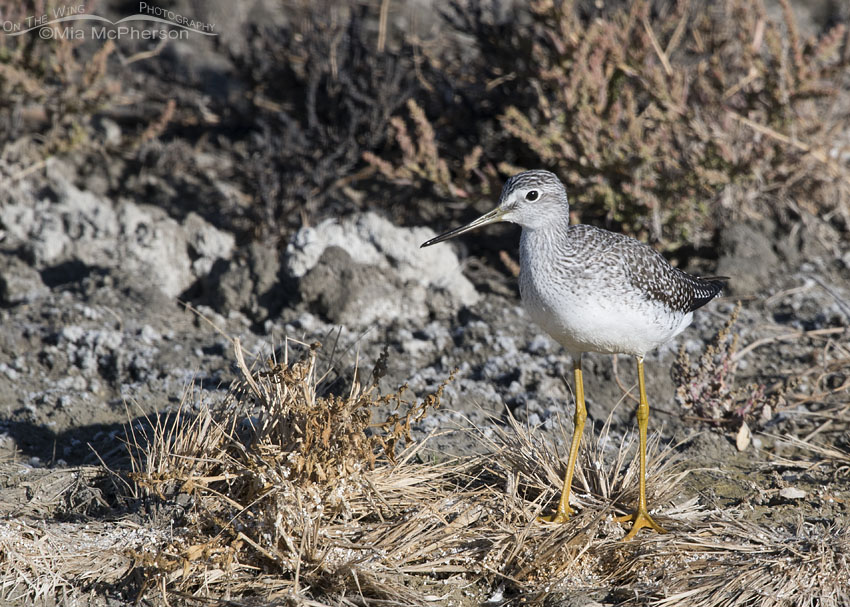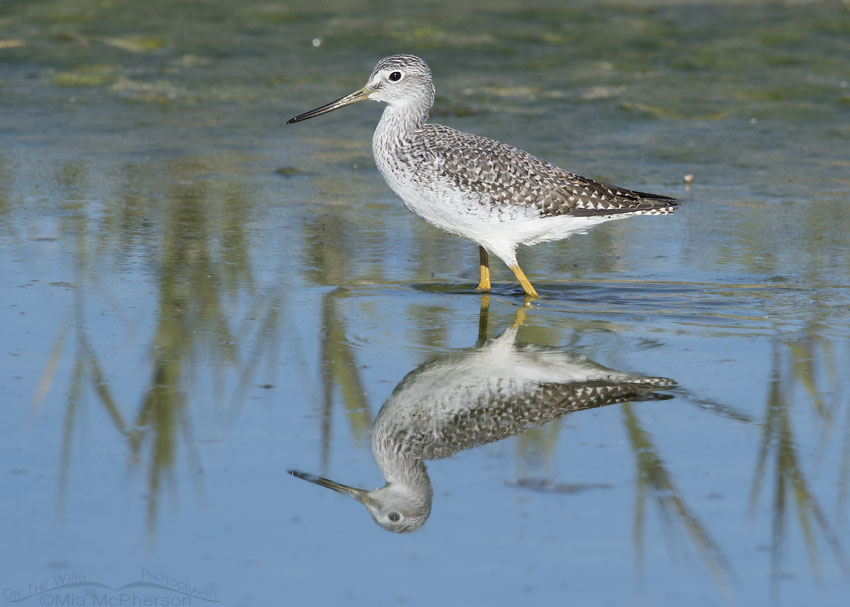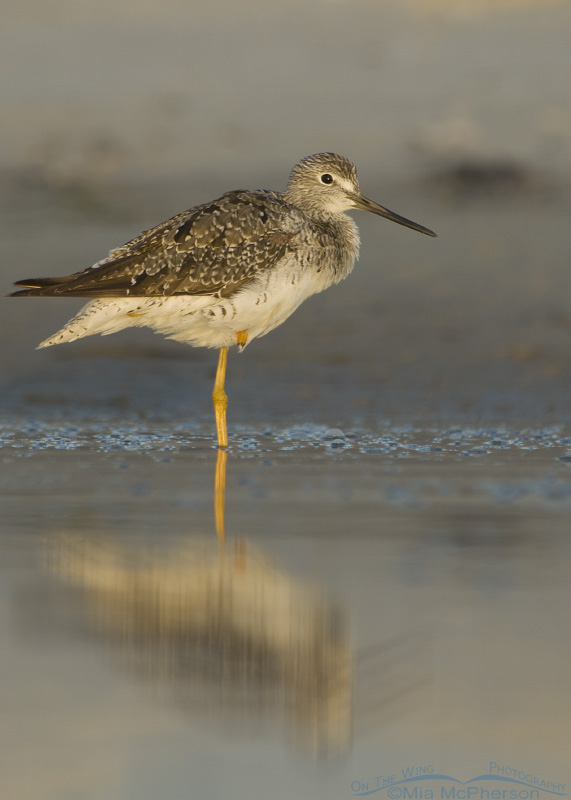 Greater Yellowlegs on the shore at Farmington Bay – Nikon D500, f7.1, 1/1250, ISO 320, Nikkor 500mm VR with 1.4x TC, natural light
Greater Yellowlegs on the shore at Farmington Bay – Nikon D500, f7.1, 1/1250, ISO 320, Nikkor 500mm VR with 1.4x TC, natural light
There are big differences in the ways I photograph Greater Yellowlegs here in Utah than there were when I photographed them in Florida. Here in Utah I photograph them primarily from inside a vehicle using it as a mobile blind. The birds seem more skittish here when they are migrating through the area and being inside a mobile blind seems to allow for closer approaches without scaring the birds away so that is an advantage.
Greater Yellowlegs breed far north of both Florida and Utah in Canada and Alaska in muskegs, wet bogs, and clearing in forests. They don’t come into contact with many people there so when they migrate south they come into contact with more and more people.
 Greater Yellowlegs walking through shallow water at Farmington Bay – Nikon D500, f7.1, 1/1000, ISO 320, Nikkor 500mm VR with 1.4x TC, natural light
Greater Yellowlegs walking through shallow water at Farmington Bay – Nikon D500, f7.1, 1/1000, ISO 320, Nikkor 500mm VR with 1.4x TC, natural light
Photographing from inside a mobile blind has its disadvantages though, because of the height of the vehicle you can’t usually get low angles, you don’t have the range of motion that you have when you are on foot and I personally believe I don’t “connect” as well with my subject. I thought about that as I photographed this bird last week.
The two photos above were taken at Farmington Bay WMA from inside a mobile blind last week, the images are okay in my opinion, the distance that I was from the bird and the reach of my long lens made the angle seem less steep than it actually was, but somehow I don’t care for them deeply or maybe they don’t appeal to me as much because I didn’t feel I connected with my subject.
 Yellowlegs at the south spit – Nikon D200, handheld, f8, 1/800, ISO 250, Nikkor 80-400mm VR at 400mm, natural light
Yellowlegs at the south spit – Nikon D200, handheld, f8, 1/800, ISO 250, Nikkor 80-400mm VR at 400mm, natural light
In Florida I used a shorter lens and carried my camera handheld, I was on foot, I generally got into the water with the shorebirds I photographed and got as low as I possibly could for two reasons, one was to get a low angle and the second was to make myself as small as possible so I didn’t look like a threat to my subjects and it worked great.
By using that type of stalking technique I got low angles and would often be at eye level with my subject or on occasion I would be lower than eye level. I felt very connected to my subjects in a wonderful, intimate way.
I was sitting in a lagoon with the Greater Yellowlegs above, my lens hood was just barely above the water as I bent down to get the lowest angle possible and as I recall I was looking slightly up at the bird.
 Restful Greater Yellowlegs – Nikon D200, handheld, f6.3, 1/250, ISO 250, Nikkor 80-400mm VR at 400mm, natural light
Restful Greater Yellowlegs – Nikon D200, handheld, f6.3, 1/250, ISO 250, Nikkor 80-400mm VR at 400mm, natural light
I was in a different lagoon at Fort De Soto County Park when I photographed this Great Yellowlegs as it rested on the shoreline in the early morning light, I was out in the lagoon laying down in the shallow water and that is why it appears that I am looking up at the bird. The water looks better at this low of an angle and truthfully I felt that I was part of the bird’s world.
You can’t feel exactly the same way sitting inside a man made vehicle. You just can’t.
I miss connecting with the shorebirds here in Utah like I did in Florida. I miss shooting handheld and being a part of their world because I am sitting in a mobile blind most of the time.
Life is good.
Mia
Click here to see more of my Greater Yellowlegs photos plus facts and information about this species.


Just beautiful. I am sorry that your mobile blind alienates you a little from your subject. And grateful you perservere.
There is something about that first image…I keep coming back to it…besutiful!!!
I keep going back to your first image,,,,something about it draws me back…beautiful bird, beautiful setting
I blame the fact all of Utah’s migratory bird “refuges” allow hunting 5 months of the year. I propose the refuges remain just that and that waterfowl hunting be only in the private hunting clubs. If the DNR feels they are loosing funds from duck licences let photographers and birders pay an entrance fee. I would pay $30-$80 yearly pass fee to enter wetland refuges similar to the Utah parks pass fee I pay to go to Antelope Island. I would truly love to see the “waterfowl resting area” just that!
Sometimes(often) I wish Florida was southern Utah, because I know you miss it so much! Then you could have the best of each world. I miss it, too. I wish Florida, Utah, Maine, NY, Colorado and a couple of others were closer together, too. Having spent time in several states, I’m always homesick for ones I’m NOT in!!!
Beautiful images of a bird we have around here in the Great Swamp, too. Always exciting to see them. Very handsome birds…